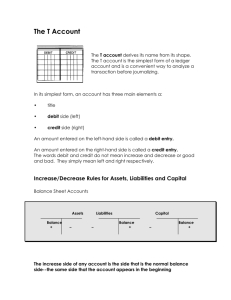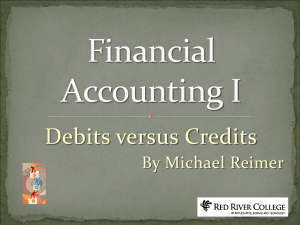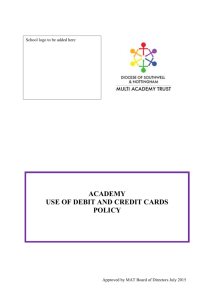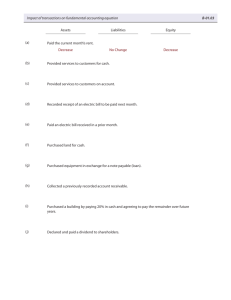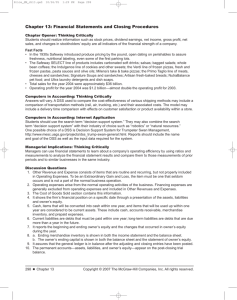File
advertisement
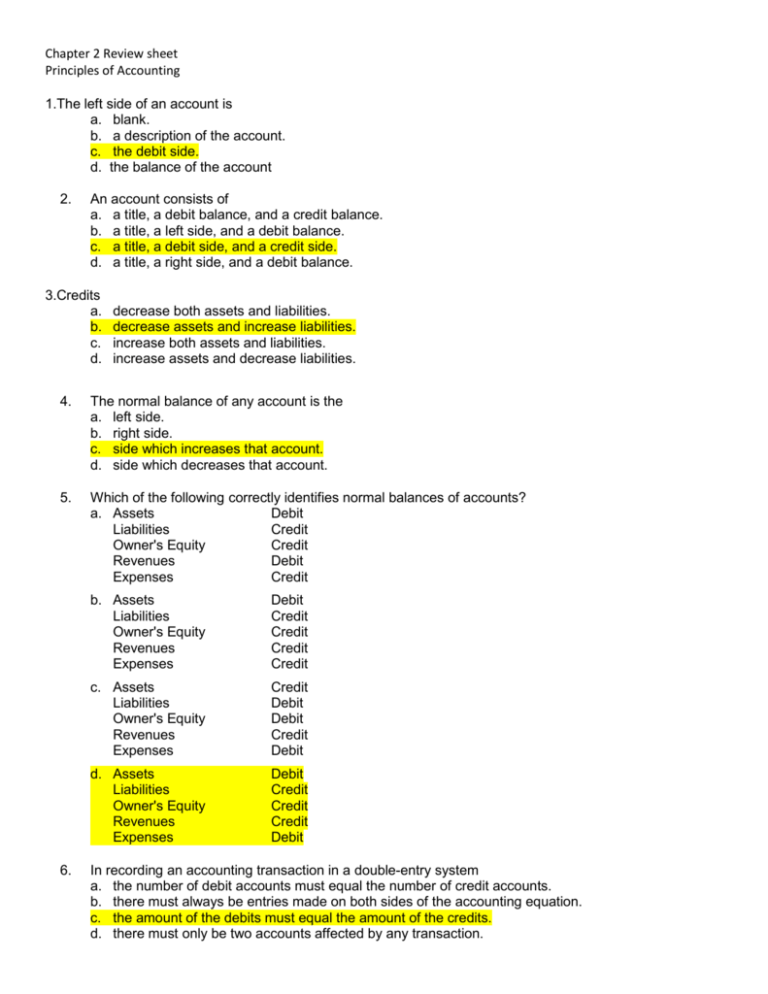
Chapter 2 Review sheet Principles of Accounting 1.The left side of an account is a. blank. b. a description of the account. c. the debit side. d. the balance of the account 2. An account consists of a. a title, a debit balance, and a credit balance. b. a title, a left side, and a debit balance. c. a title, a debit side, and a credit side. d. a title, a right side, and a debit balance. 3.Credits a. b. c. d. decrease both assets and liabilities. decrease assets and increase liabilities. increase both assets and liabilities. increase assets and decrease liabilities. 4. The normal balance of any account is the a. left side. b. right side. c. side which increases that account. d. side which decreases that account. 5. Which of the following correctly identifies normal balances of accounts? a. Assets Debit Liabilities Credit Owner's Equity Credit Revenues Debit Expenses Credit 6. b. Assets Liabilities Owner's Equity Revenues Expenses Debit Credit Credit Credit Credit c. Assets Liabilities Owner's Equity Revenues Expenses Credit Debit Debit Credit Debit d. Assets Liabilities Owner's Equity Revenues Expenses Debit Credit Credit Credit Debit In recording an accounting transaction in a double-entry system a. the number of debit accounts must equal the number of credit accounts. b. there must always be entries made on both sides of the accounting equation. c. the amount of the debits must equal the amount of the credits. d. there must only be two accounts affected by any transaction. 7. If a company has overdrawn its bank balance, then a. its cash account will show a debit balance. b. its cash account will show a credit balance. c. the cash account debits will exceed the cash account credits. d. it cannot be detected by observing the balance of the cash account. 8. TransAm Mail Service purchased equipment for $2,000. TransAm paid $400 in cash and signed a note for the balance. TransAm debited the Equipment account, credited Cash and a. nothing further must be done. b. debited the Capital account for $1,600. c. credited another asset account for $400. d. credited a liability account for $1,600. 9. Chik Chik Company showed the following balances at the end of its first year: Cash Prepaid insurance Accounts receivable Accounts payable Notes payable Owner’s Capital Owner’s Drawings Revenues Expenses $ 6,000 9,400 7000 5,600 8,400 2,800 1,400 44,000 35,000 What did Chik Chik Company show as total credits on its trial balance? a. $51,400 b. $60,800 c. $62,200 d. $70,200 10. 11. The final step in the recording process is to a. analyze each transaction. b. enter the transaction in a journal. c. prepare a trial balance. d. transfer journal information to ledger accounts. The first step in the recording process is to a. prepare financial statements. b. analyze each transaction for its effect on the accounts. c. post to a journal. d. prepare a trial balance. 12.The recording process occurs a. once a year. b. once a month. c. repeatedly during the accounting period. d. infrequently in a manual accounting system. 13Transactions in a journal are initially recorded in a. account number order. b. dollar amount order. c. alphabetical order. d. chronological order. 14.Which of the following journal entries is recorded correctly and in the standard format? a. Salaries and Wages Expense ............................................ 500 Cash ............................................................................. 1,500 Advertising Expense ........................................................... 1,000 b. Salaries and Wages Expense . ........................................... Advertising Expense ........................................................... Cash ............................................................................. 500 1,000 1,500 c. Cash .................................................................................. Salaries and Wages Expense ....................................... Advertising Expense ..................................................... 1,500 d. Salaries and Wages Expense ............................................ Advertising Expense ........................................................... Cash . ............................................................................ 500 1,000 500 1,000 1,500 15.A chart of accounts usually starts with a. asset accounts. b. expense accounts. c. liability accounts. d. revenue accounts. 16.A trial balance is a listing of a. transactions in a journal. b. the chart of accounts. c. general ledger accounts and balances. d. the totals from the journal pages. BE 1 Journalize the following business transactions in general journal form. Identify each transaction by number. You may omit explanations of the transaction. 1. Andrew Bird invested $35,000 cash to start an appliance repair business. 2. Hired an employee to be paid $400 per week, starting tomorrow. 3. Paid two years’ rent in advance, $7,440. 4. Paid the worker’s weekly wage. 5. Recorded revenue earned and received for the week, $1,900. ANSWER: 1. Cash……. ....................................................................................... Owner’s Capital ...................................................................... 35,000 35,000 2. No entry, not a transaction. 3. Prepaid Rent................................................................................... Cash ...................................................................................... 4. Salaries and Wages Expense ......................................................... Cash ...................................................................................... 7,440 5. Cash………. ................................................................................... Service Revenue .................................................................... 1,900 7,440 400 400 1,900 BE2 The transactions of the Liberty Belle Store are recorded in the general journal below. You are to post the journal entries to T-accounts. General Journal ____________________________________________________________________________ Date Account Titles Debit Credit ____________________________________________________________________________ 2014 Aug. 5 Accounts Receivable 4,400 Service Revenue 4,400 10 Cash 3,000 Service Revenue 19 25 3,000 Rent Expense Cash 1,100 Cash 1,400 1,100 Accounts Receivable 1,400 ANSWERS: General Ledger Cash 8/10 8/25 3,000 1,400 8/31 Bal. 3,300 Accounts Receivable 8/19 1,100 8/5 8/25 8/31 Bal. 3,000 Service Revenue 8/5 8/10 8/31 Bal. 4,400 Rent Expense 4,400 3,000 7,400 8/19 1,100 8/31 Bal. 1,100 1,400 BE 3 Prepare a corrected trial balance for Stereolab Company. All accounts should have a normal balance. STEROELAB COMPANY Trial Balance For the Quarter Ended 3/31/14 Cash Accounts Receivable Prepaid Insurance Equipment Accounts Payable Unearned Service Revenue Notes Payable Owner’s Capital Owner’s Drawings Service Revenue Salaries and Wages Expense Utilities Expense Rent Expense Debit $ 14,000 Credit $ 23,000 2,500 60,000 15,000 10,000 25,000 38,000 1,500 43,000 15,000 5,000 10,000 $116,500 $145,500 Answers: Prepare a corrected trial balance for Stereolab Company. All accounts should have a normal balance. STEROELAB COMPANY Trial Balance For the Quarter Ended 3/31/14 Cash Accounts Receivable Prepaid Insurance Equipment Accounts Payable Unearned Service Revenue Notes Payable Owner’s Capital Owner’s Drawings Service Revenue Salaries and Wages Expense Utilities Expense Rent Expense Debit $ 14,000 Credit $ 23,000 2,500 60,000 15,000 10,000 25,000 38,000 1,500 43,000 15,000 5,000 10,000 $116,500 $145,500 Ex. 1 The chart of accounts used by Notwist Copy Company is listed below. You are to indicate the proper accounts to be debited and credited for the following transactions by writing the account number(s) in the appropriate boxes. CHART OF ACCOUNTS 101 Cash 209 Unearned Service Revenue 112 Accounts Receivable 301 Owner’s Capital 125 Supplies 306 Owner’s Drawings 157 Equipment 400 Service Revenue 200 Notes Payable 610 Advertising Expense 201 Accounts Payable 729 Rent Expense ——————————————————————————————————————————— ——————————————————————————————————————————— Number(s) Number(s) of account(s) of account(s) debited credited 1. M. Acher invests $70,000 cash to start the business. 101 301 ——————————————————————————————————————————— 2. Purchased three pieces of equipment for $160,000, paying $50,000 cash and signing a 5-year, 10% note for the remainder. 157 101,200 ——————————————————————————————————————————— 3. Purchased $5,000 supplies on credit. 125 201 ——————————————————————————————————————————— 4. Cash revenue amounted to $7,000. 101 400 ——————————————————————————————————————————— 5. Paid $500 cash for radio advertising. 610 101 ——————————————————————————————————————————— 6. Paid $800 on account for supplies purchased in transaction 3. 201 101 ——————————————————————————————————————————— 7. Owner withdrew $2,100 from the business for personal expenses. 306 101 ——————————————————————————————————————————— 8. Paid $1,200 cash for rent for the current month. 729 101 ——————————————————————————————————————————— 9. Received $2,000 cash advance from a customer for future copying. 101 209 ——————————————————————————————————————————— 10. Billed a customer for $575 for photocopy work done. 112 400 ——————————————————————————————————————————— Ex. 2 The ledger accounts of the Fabulous Muscles Gym at June 30, 2014 are shown below: Accounts Payable Accounts Receivable Buildings Owner’s Capital Cash Equipment Notes Payable Supplies Owner’s Drawings $ 9,100 8,050 43,000 61,800 6,100 42,900 40,000 350 10,500 Instructions Prepare a trial balance with the ledger accounts arranged in the proper financial statement order. Include the appropriate heading. Answers: FABULOUS MUSCLES GYM Trial Balance June 30, 2014 Cash ............................................................................................... Accounts Receivable ...................................................................... Supplies ......................................................................................... Equipment ...................................................................................... Buildings ......................................................................................... Notes Payable ................................................................................ Accounts Payable ........................................................................... Owner’s Capital .............................................................................. Owner’s Drawings .......................................................................... Totals ..................................................................................... Debit $ 6,100 8,050 350 42,900 43,000 Credit $ 40,000 9,100 61,800 10,500 $110,900 $110,900

